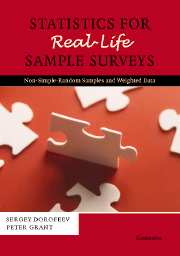Book contents
- Frontmatter
- Contents
- Preface
- 1 Sampling methods
- 2 Weighting
- 3 Statistical effects of sampling and weighting
- 4 Significance testing
- 5 Measuring relationships between variables
- Appendix A Review of general terminology
- Appendix B Further reading
- Appendix C Summary tables for several common distributions
- Appendix D Chapter 2 mathematical proofs
- Appendix E Chapter 3 mathematical proofs
- Appendix F Chapter 4 mathematical proofs
- Appendix G Chapter 5 mathematical proofs
- Appendix H Statistical tables
- References
- Index
5 - Measuring relationships between variables
Published online by Cambridge University Press: 18 August 2009
- Frontmatter
- Contents
- Preface
- 1 Sampling methods
- 2 Weighting
- 3 Statistical effects of sampling and weighting
- 4 Significance testing
- 5 Measuring relationships between variables
- Appendix A Review of general terminology
- Appendix B Further reading
- Appendix C Summary tables for several common distributions
- Appendix D Chapter 2 mathematical proofs
- Appendix E Chapter 3 mathematical proofs
- Appendix F Chapter 4 mathematical proofs
- Appendix G Chapter 5 mathematical proofs
- Appendix H Statistical tables
- References
- Index
Summary
Analysis of contingency tables
One of the goals of any survey is to study relationships between variables and it is important to be able to measure how strongly two variables are associated. In many (if not most) cases, it is actually more useful to know the strength of association between variables rather than to test a hypothesis and conclude that a difference is ‘significant’ or not. It might be, for example, that for two given pairs of variables, significance testing will result in the conclusion that variables in both pairs are not independent. However, these two pairs may still have very different degrees of association for variables within each of them. Therefore, it is important to know not just the ‘yes/no’ answer but the magnitude or strength of the association between variables. The level of statistical significance is, of course, in part a function of the sample size, whereas the strength of the association is independent of sample size.
Numerical and categorical variables
Let us begin by discriminating between two major types of variables, those that are inherently numerical and those that are not.
Numerical variables sometimes have an absolute numerical value (height, age, income, etc.), and although different units of measurement may be used (height in inches, centimetres or metres) the relative values for different respondents are preserved and the nature of the results will not be affected by the choice.
- Type
- Chapter
- Information
- Statistics for Real-Life Sample SurveysNon-Simple-Random Samples and Weighted Data, pp. 172 - 226Publisher: Cambridge University PressPrint publication year: 2006



